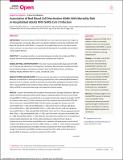Association of Red Blood Cell Distribution Width With Mortality Risk in Hospitalized Adults With SARS-CoV-2 Infection
Author(s)
Foy, Brody H.; Carlson, Jonathan C. T.; Reinertsen, Erik; Padros I. Valls, Raimon; Pallares Lopez, Roger; Palanques-Tost, Eric; Mow, Christopher; Westover, M. Brandon; Aguirre, Aaron D.; Higgins, John M.; ... Show more Show less
Downloadfoy_2020_oi_200742_1600294792.15315.pdf (1.051Mb)
Publisher with Creative Commons License
Publisher with Creative Commons License
Creative Commons Attribution
Terms of use
Metadata
Show full item recordAbstract
Importance Coronavirus disease 2019 (COVID-19) is an acute respiratory illness with a high rate of hospitalization and mortality. Biomarkers are urgently needed for patient risk stratification. Red blood cell distribution width (RDW), a component of complete blood counts that reflects cellular volume variation, has been shown to be associated with elevated risk for morbidity and mortality in a wide range of diseases.
Objective To investigate whether an association between mortality risk and elevated RDW at hospital admission and during hospitalization exists in patients with COVID-19.
Design, Setting, and Participants This cohort study included adults diagnosed with SARS-CoV-2 infection and admitted to 1 of 4 hospitals in the Boston, Massachusetts area (Massachusetts General Hospital, Brigham and Women’s Hospital, North Shore Medical Center, and Newton-Wellesley Hospital) between March 4, 2020, and April 28, 2020.
Main Outcomes and Measures The main outcome was patient survival during hospitalization. Measures included RDW at admission and during hospitalization, with an elevated RDW defined as greater than 14.5%. Relative risk (RR) of mortality was estimated by dividing the mortality of those with an elevated RDW by the mortality of those without an elevated RDW. Mortality hazard ratios (HRs) and 95% CIs were estimated using a Cox proportional hazards model.
Results A total of 1641 patients were included in the study (mean [SD] age, 62[18] years; 886 men [54%]; 740 White individuals [45%] and 497 Hispanic individuals [30%]; 276 nonsurvivors [17%]). Elevated RDW (>14.5%) was associated with an increased mortality risk in patients of all ages. The RR for the entire cohort was 2.73, with a mortality rate of 11% in patients with normal RDW (1173) and 31% in those with an elevated RDW (468). The RR in patients younger than 50 years was 5.25 (normal RDW, 1% [n = 341]; elevated RDW, 8% [n = 65]); 2.90 in the 50- to 59-year age group (normal RDW, 8% [n = 256]; elevated RDW, 24% [n = 63]); 3.96 in the 60- to 69-year age group (normal RDW, 8% [n = 226]; elevated RDW, 30% [104]); 1.45 in the 70- to 79-year age group (normal RDW, 23% [n = 182]; elevated RDW, 33% [n = 113]); and 1.59 in those ≥80 years (normal RDW, 29% [n = 168]; elevated RDW, 46% [n = 123]). RDW was associated with mortality risk in Cox proportional hazards models adjusted for age, D-dimer (dimerized plasmin fragment D) level, absolute lymphocyte count, and common comorbidities such as diabetes and hypertension (hazard ratio of 1.09 per 0.5% RDW increase and 2.01 for an RDW >14.5% vs ≤14.5%; P < .001). Patients whose RDW increased during hospitalization had higher mortality compared with those whose RDW did not change; for those with normal RDW, mortality increased from 6% to 24%, and for those with an elevated RDW at admission, mortality increased from 22% to 40%.
Conclusions and Relevance Elevated RDW at the time of hospital admission and an increase in RDW during hospitalization were associated with increased mortality risk for patients with COVID-19 who received treatment at 4 hospitals in a large academic medical center network.
Date issued
2020-09Department
Massachusetts Institute of Technology. Research Laboratory of ElectronicsJournal
JAMA Network Open
Publisher
American Medical Association (AMA)
Citation
Foy, Brody H. et al. "Association of Red Blood Cell Distribution Width With Mortality Risk in Hospitalized Adults With SARS-CoV-2 Infection." JAMA Network Open 3, 9 (September 2020): e2022058.
Version: Final published version
ISSN
2574-3805